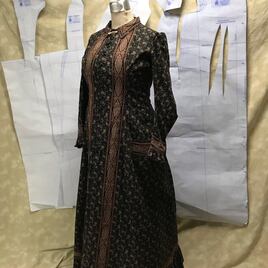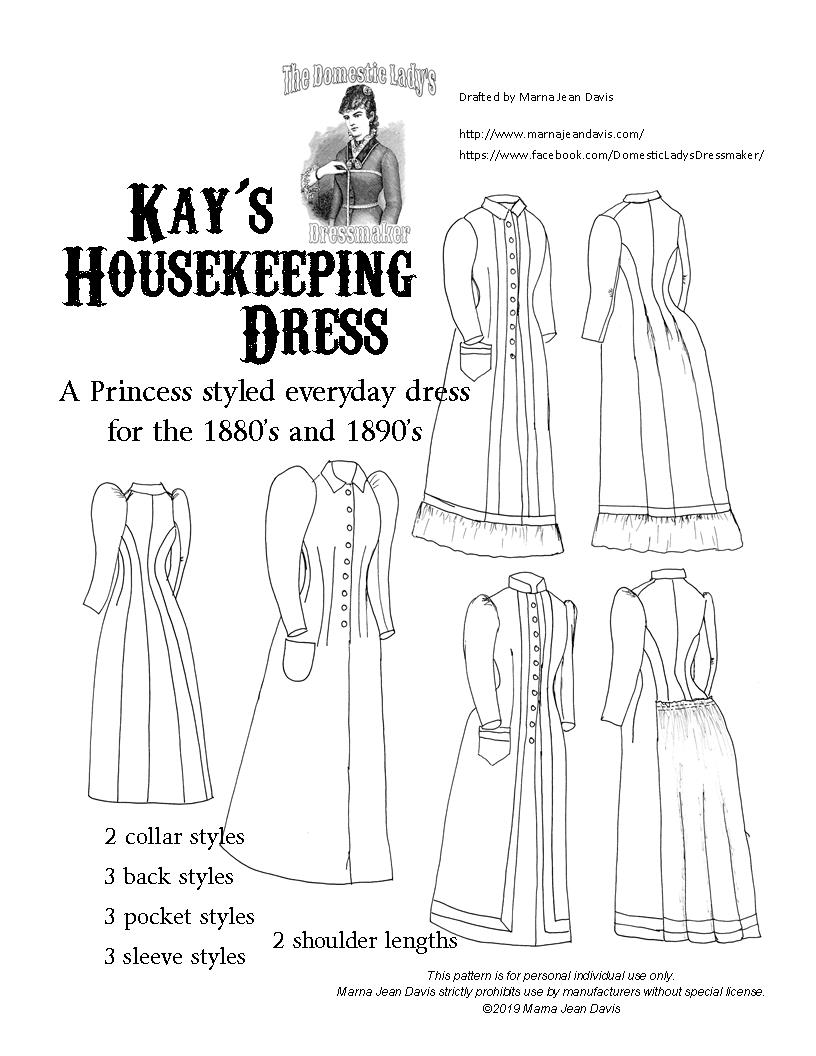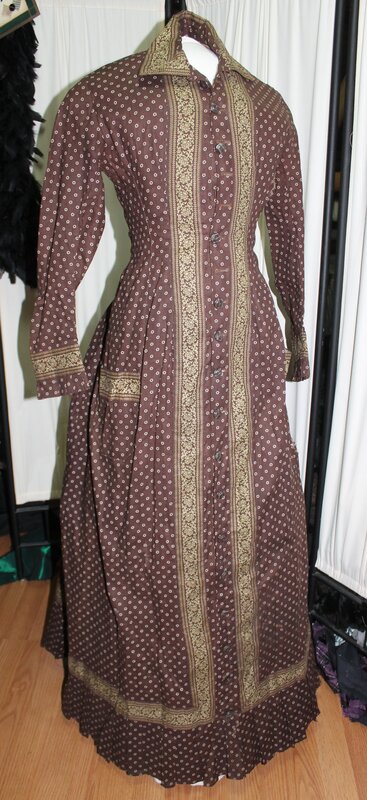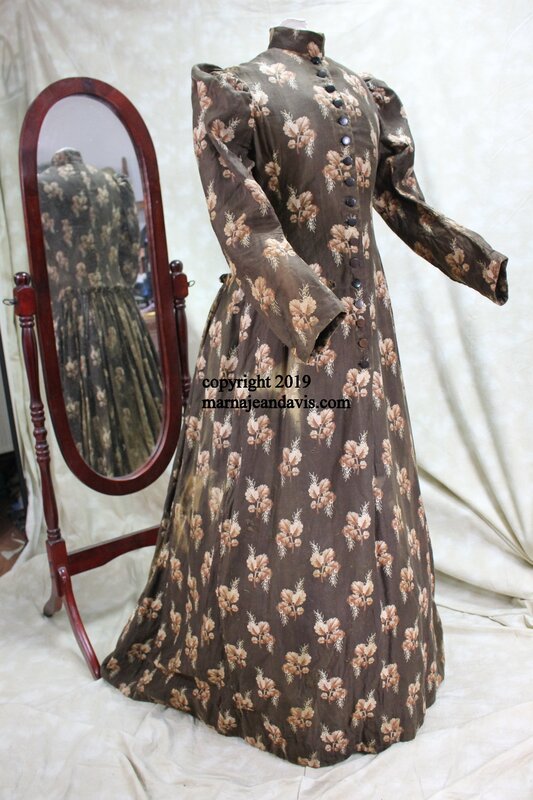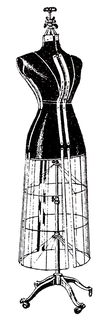
Introducing the Originals-
This pattern is based on general pattern shapes from the 1880’s through the 1890’s, but is most closely drafted after an 1880’s original dress in my collection. This original gown is brown cotton, with applied trim cut from a contrasting green/brown print. It is half lined (to the hip) and opens only about halfway down the front, the bottom half being sewn shut permanently with buttons sewn on over the top to make it appear as if it buttons all the way down the front.
A second dress was used in making the adaptations for the 1890’s options, a brown print sateen dress that shows fairly hard wear. It is fully lined as is usual with wool and sateen dresses. It has a short stand up style collar rather than the rolling collar of the 1880’s dress- but I have seen 1890’s dresses with the rolling collar (and 1880’s with a stand up collar.) This dress also surprisingly shows a gathered back panel with the 1890’s shaped sleeves, leading me to believe it probably dates to about 1892-1893.
This pattern is based on general pattern shapes from the 1880’s through the 1890’s, but is most closely drafted after an 1880’s original dress in my collection. This original gown is brown cotton, with applied trim cut from a contrasting green/brown print. It is half lined (to the hip) and opens only about halfway down the front, the bottom half being sewn shut permanently with buttons sewn on over the top to make it appear as if it buttons all the way down the front.
A second dress was used in making the adaptations for the 1890’s options, a brown print sateen dress that shows fairly hard wear. It is fully lined as is usual with wool and sateen dresses. It has a short stand up style collar rather than the rolling collar of the 1880’s dress- but I have seen 1890’s dresses with the rolling collar (and 1880’s with a stand up collar.) This dress also surprisingly shows a gathered back panel with the 1890’s shaped sleeves, leading me to believe it probably dates to about 1892-1893.
What will the class entail?
Cutting out and fitting your pattern/muslin for a perfect neat historical appearance.
If you have fitting issues I will work with you to make sure you are taking home a flattering dress. You will walk away with an adjusted pattern for your figure and the knowledge of how to "fix" future patterns. Do you have problems with a large upper arm fit? I have a historically correct solution. Do you fight with wrinkles and binding at the armscye? We can fix that. Do you have a hard time getting a pattern in your size? My patterns range from 32 to 53 bust measurement BUT for this class if you need something outside that range you may email me and we will make sure you have the pattern you need.
19th century speed sewing techniques with the sewing machine.
While hand sewing may have been the most common way before the civil war, in the industrial period after sewing machines became extremely common. A large portion of early bustle dresses I have examined make use of this handy new helper to the woman's everyday life.
Hands on examination of these extant dresses
and comparasion to some others in my collection (yes you can take photos to help you remember how things are done!)
Understanding common dress style for everyday wear.
This is a basic style, but we will talk about some other common pattern shapes worn during this timeframe.
As always my patterns come complete with historical notes and images from my photograph collection to show how the gowns were "really worn".
Cutting out and fitting your pattern/muslin for a perfect neat historical appearance.
If you have fitting issues I will work with you to make sure you are taking home a flattering dress. You will walk away with an adjusted pattern for your figure and the knowledge of how to "fix" future patterns. Do you have problems with a large upper arm fit? I have a historically correct solution. Do you fight with wrinkles and binding at the armscye? We can fix that. Do you have a hard time getting a pattern in your size? My patterns range from 32 to 53 bust measurement BUT for this class if you need something outside that range you may email me and we will make sure you have the pattern you need.
19th century speed sewing techniques with the sewing machine.
While hand sewing may have been the most common way before the civil war, in the industrial period after sewing machines became extremely common. A large portion of early bustle dresses I have examined make use of this handy new helper to the woman's everyday life.
Hands on examination of these extant dresses
and comparasion to some others in my collection (yes you can take photos to help you remember how things are done!)
Understanding common dress style for everyday wear.
This is a basic style, but we will talk about some other common pattern shapes worn during this timeframe.
As always my patterns come complete with historical notes and images from my photograph collection to show how the gowns were "really worn".
Supplies needed:
Lining (estimate 2-3 yards): Originals show linings made from leftover fabric from other cotton dresses, feed or flour sacking, plain weave fabric in white, tan, or brown, polished cotton, fine light twill weave shirting in a tan or light brown, and my personal favorite for hot climates- a lightweight linen.
Main Fabric (estimate 8-9 yds 45"): a historical cotton print, or a suiting or tropical weight 100% wool.
Muslin or other scrap fabric to make a fitting muslin This fabric should be firm plain weave, it can be a poly blend as we are just going to use it to make sure your pattern fits ideally. Old sheets work great for this. You just need enough for the bodice and possibly a single sleeve.
Tracing paper if you want to save your pattern intact.
Notions: 12-14 Buttons - about 1/2" to 3/4" size work- common are mother of pearl, china, vegetable ivory. Thread to match main fabric, your favorite sewing needles and pins, sewing machine (most originals make heavy use of machine sewing). general sewing supplies Sewing supplies: paper scissors, fabric scissors, pins, marking pens/chalk for darts
Skills Needed
You need basic sewing skills, be able to use a sewing machine and sew straight and curved lines.
You should be able to read a tape measure
If you wear a corset, please bring it so we can properly fit your dress.
